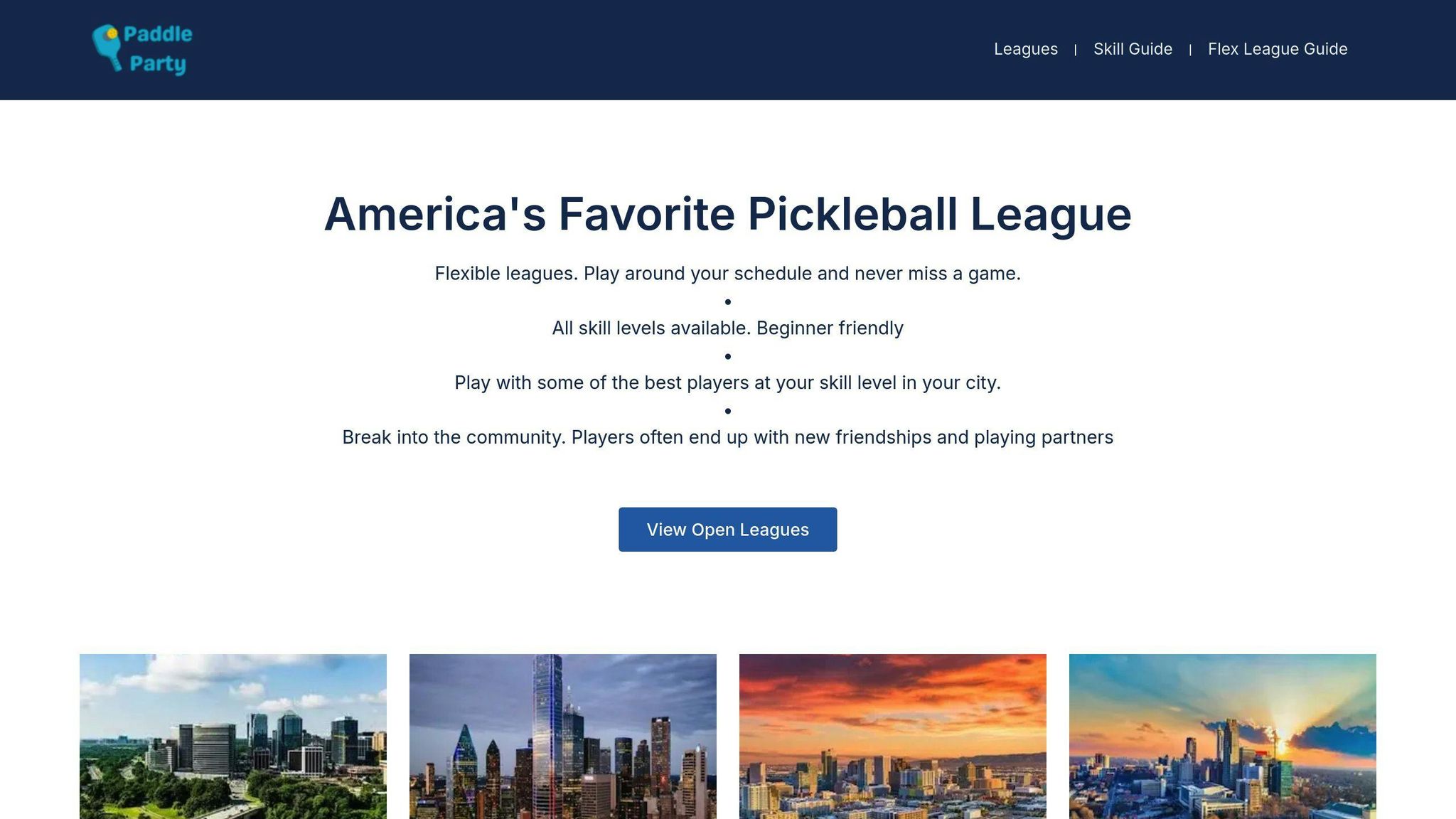Balancing work and pickleball is easier than you think. With the right strategies, you can stay productive at your job while enjoying your time on the court. Here’s how:
- Plan Your Schedule: Use tools like Google Calendar to map out work, family, and pickleball commitments.
- Set Clear Goals: Aim for realistic pickleball and career objectives using the SMART framework.
- Make Pickleball Routine: Schedule games during low-stress times like mornings or evenings.
- Communicate Well: Keep your boss and teammates informed about your availability.
- Stay Organized: Use time-blocking, checklists, and reminders to keep everything on track.
- Prioritize Health: Sleep well, eat right, and manage stress to perform better at work and on the court.
- Try Flexible Leagues: Join leagues with adjustable schedules like Paddle Party to fit your lifestyle.
- Review and Adjust: Regularly evaluate your schedule and tweak it as needed.
Quick Tip: Treat pickleball sessions like important appointments and use tools to manage your time effectively. Whether you’re a beginner or experienced player, these steps can help you balance work and play seamlessly.
How to Organize a Recreational Pickleball Event
1. Evaluate Your Schedule
Balancing work and pickleball begins by outlining your non-negotiable commitments, like work hours and family responsibilities. Tools like Google Calendar can make this process easier by helping you spot open time slots for pickleball.
Here are a few ideas for fitting games into your routine:
- Early mornings: Start your day with a quick session before work.
- Lunch breaks: Use this time for a short game to recharge.
- Evenings: Unwind with matches after your workday.
Think about scheduling pickleball during your less productive work hours or when you naturally have more energy. Don’t forget to factor in travel time and preparation when planning your games.
Many leagues offer flexible schedules, with games available throughout the day, making it easier to work around your job. The goal is to create a routine that lets you stay productive at work while enjoying regular pickleball sessions.
Once your schedule is mapped out, you’ll be ready to set achievable goals that align with your availability.
2. Set Achievable Goals
Once you’ve reviewed your schedule, it’s time to define clear goals for both your work and pickleball activities. Focus on creating objectives that fit your time and energy, using the SMART framework to keep them specific and manageable.
Here’s a breakdown of how you can structure your goals:
| Area | Short-term Goals | Long-term Goals |
|---|---|---|
| Work | Complete daily tasks, meet weekly deadlines | Advance your career, build new skills |
| Pickleball | Stick to a practice routine, sharpen specific skills | Compete in tournaments, improve your rating |
Start by aiming for 2-3 pickleball sessions each week. This gives you enough time to stay productive at work while also making steady progress on the court.
Use measurable targets to track your improvement. For example, instead of saying, “get better at pickleball,” you could aim to “cut serve errors by 20% over the next three months”. Break larger goals into smaller, actionable steps, and consider using tools or apps to monitor your progress. Reassess these goals monthly to adapt to changes in work or league schedules.
Life happens, so don’t hesitate to tweak your goals when responsibilities shift. With a solid plan in place, you’ll be well-prepared to balance pickleball and work. Up next, we’ll dive into how to integrate pickleball into your daily routine.
3. Make Pickleball Part of Your Routine
Once you’ve set clear goals, the next step is weaving pickleball into your daily life. By planning ahead, you can ensure pickleball fits seamlessly into your schedule without clashing with work or other responsibilities.
Pick specific times for pickleball that match your energy levels. If you’re most focused in the mornings, save your pickleball sessions for later in the day, like the afternoon or evening. This way, you can stay productive at work and still enjoy time on the court.
Here’s an example of how to plan your pickleball routine:
| Time of Day | Activity | Benefits |
|---|---|---|
| Early Morning | Pre-work practice | Boosts energy for the day, avoids conflicts |
| Lunch Break | Quick drills or games | Refreshes your mind, improves focus later |
| After Work | League matches | Helps unwind, creates a clear work-play divide |
Treat your pickleball sessions like important appointments – non-negotiable. Use scheduling tools to block out time for the court, making it easier to keep other commitments from interfering.
Create a pre-game ritual to set yourself up for success. This could include stretching, mentally preparing, or organizing your gear the night before. The social side of pickleball can also help keep you motivated. Joining leagues or groups that match your availability adds accountability and enjoyment.
Give yourself some buffer time around your pickleball activities to avoid feeling rushed. A well-thought-out routine can help you manage stress and make it easier to balance work and play.
Pay attention to how your schedule affects your energy and productivity. If you find certain times work better than others, adjust accordingly to get the most out of both your job and your pickleball sessions.
Once you’ve nailed down a routine, staying organized will help you juggle all your priorities with ease.
4. Communicate with Your Team and Boss
Letting your boss and team know about your pickleball schedule helps avoid misunderstandings and builds trust. Schedule a meeting with your boss to explain how you’ll manage both work responsibilities and your pickleball commitments. Share a clear plan and be ready to address any concerns about your availability or productivity.
Here’s a quick guide for keeping everyone informed:
| Communication Channel | Purpose | Best Practices |
|---|---|---|
| Shared Calendar | Block out league matches and practice times | Update at least two weeks in advance |
| Team Chat Platform | Share quick updates or schedule changes | Notify team members within 24 hours |
| Submit formal time-off requests | Send at least one week before matches |
Using tools like shared calendars, chat platforms, and email ensures that your team stays updated. Make it a habit to plan ahead by updating schedules two weeks in advance and promptly notifying your team of any changes. This allows everyone to adjust their plans and avoid potential conflicts.
If work priorities clash with your pickleball schedule, stay flexible. You can reschedule matches or find substitutes to keep things running smoothly. Consistently updating your team shows you value their time and are committed to balancing your responsibilities.
Clear communication keeps everyone aligned and supports your efforts to stay organized. With a solid plan in place, you’ll be able to stick to your commitments without missing a beat.
sbb-itb-b64fdb6
5. Keep Organized
Balancing work and pickleball becomes much easier when you stay organized. A great way to manage both is by time-blocking. For example, schedule 2-hour blocks for matches and 1-hour blocks for practice in a digital calendar. This keeps your commitments clear and manageable.
| Tool | Purpose | Tips for Use |
|---|---|---|
| Digital Calendar | Plan your schedule | Block time for matches and practice, set reminders |
| Equipment Checklist | Ensure gear is ready | Check it the night before |
| Task Priority Matrix | Manage tasks | Sort by urgency and importance |
To stay productive without burning out, try the Pomodoro Technique: work in 25-minute focused intervals, followed by short breaks. This method helps you conserve energy for your matches and practices.
It’s also smart to keep a ready-to-go bag packed with essentials like paddles, balls, a water bottle, and athletic wear. Set reminders in your calendar – 24 hours before matches and 15 minutes before leaving – to avoid last-minute scrambling.
Here are some practical tips for staying organized:
- Use a digital calendar with automated reminders to block time for matches and practice.
- Pack your gear the night before and review your weekly schedule every Sunday.
- Keep a backup set of equipment at work for unexpected games.
- Set clear boundaries between work time and pickleball time to avoid overlap.
Once you’ve got your schedule and tools in place, you’ll be better prepared to focus on maintaining your health for both work and pickleball.
6. Prioritize Health and Well-being
Balancing work and pickleball can feel like a juggling act, but staying healthy can make it much easier – and more productive. In fact, a solid work-life balance can boost productivity by 21%. Taking care of your physical and mental health is key to performing well both on the job and on the court.
Here’s a quick look at how health impacts both areas:
| Health Aspect | Work Benefits | Pickleball Benefits |
|---|---|---|
| Regular Exercise | Better focus and productivity | Enhanced gameplay performance |
| Proper Nutrition | Steady energy throughout the day | Improved endurance during games |
| Adequate Sleep | Sharper decision-making | Faster recovery between matches |
| Stress Management | Less workplace anxiety | Improved court awareness |
Focus on These Essentials
- Sleep and Recovery: Aim for 7-8 hours of sleep each night. Create a nighttime routine to help you unwind after work or pickleball. Sleep tracking apps can help you spot patterns and make improvements.
- Nutrition Planning: Keep meals balanced to fuel both work and play. Stock up on healthy snacks to maintain energy levels throughout the day.
- Stress Management: Add small stress-relief habits like 10-minute meditations or breathing exercises to your daily schedule. Playing pickleball during stressful periods can also be a great way to relax.
- Injury Prevention: Warm up with dynamic stretches before games to avoid injuries and improve mobility. Pay attention to your body’s signals, and communicate any physical concerns with your teammates.
Once you’ve got your health in a good place, exploring flexible pickleball leagues can make balancing everything even smoother.
7. Use Flexible Leagues like Paddle Party

For busy professionals, leagues like Paddle Party offer a way to enjoy pickleball without the rigid schedules of traditional leagues. These leagues are designed with features like adjustable scheduling, divisions based on skill, shorter seasons, and help with finding partners – making it easier to fit pickleball into a packed calendar.
| Feature | What It Offers |
|---|---|
| Dynamic Scheduling | Play at times that work for you |
| Skill-Based Divisions | Compete with players at your level |
| Shorter Seasons | Easier to fit into a busy schedule |
| Partner Assistance | Help with finding teammates |
These leagues follow the guidelines of the USA Pickleball 2024 Official Rulebook but allow you to schedule matches at your convenience. This means you can keep up with your work responsibilities while still improving your pickleball skills.
Making the Most of Flexible Leagues
To get the best experience, keep track of your progress with DUPR updates and share your scheduling needs with league administrators. Unlike traditional leagues, flexible ones let you adjust your schedule as needed, making it easier to keep pickleball in your routine.
Good communication is key. Let league admins know about any changes in your availability so you can stay on track without missing out. This way, you can balance your work and personal life while enjoying the game.
With leagues like these, you can keep pickleball in your life no matter how busy things get.
8. Monitor and Adjust
Balancing work and pickleball requires regular checks and tweaks to keep everything running smoothly. By reviewing your schedule and staying alert to signs of imbalance, you can handle both commitments while staying energized and productive.
Weekly Schedule Reviews
Take a few minutes every Sunday evening to go over your upcoming week. Check for any clashes between work deadlines and pickleball matches. This simple habit helps you catch potential conflicts early and plan ahead.
| What to Review | What to Do |
|---|---|
| Work Tasks | Confirm deadlines and meeting times |
| Pickleball Plans | Double-check match schedules and practice sessions |
| Energy Levels | Plan intense tasks or matches when you’re most energized |
| Rest and Recovery | Block out time to recharge between commitments |
Stay Flexible and Adjust
Look out for warning signs like being late often, missing deadlines, or feeling constantly drained. These could mean your schedule needs tweaking. Be open to making changes – whether it’s shifting a match or rescheduling a work task – and communicate updates with your teammates and employer to keep everyone in the loop.
Use Tools to Stay on Track
Keep your calendar updated as priorities shift. Fitness apps can also help you monitor your energy levels and recovery times, giving you insights into how to adjust your schedule effectively.
Balancing work and pickleball isn’t a one-time fix. Your approach might need to change during busier work seasons or after a particularly intense match. Pay attention to how you’re feeling and make adjustments as needed to stay productive at work while still enjoying your time on the court.
Conclusion
Finding a balance between work and pickleball is possible with thoughtful planning and consistent effort. Incorporating activities like pickleball into your routine can boost productivity, lower stress, and improve your overall quality of life.
Here’s how maintaining balance can make a difference:
| Area | Benefits of Balance |
|---|---|
| Professional Life | Better focus, higher productivity, reduced stress |
| Physical Health | Regular exercise, increased energy, quicker recovery |
| Time Management | Organized routines, clear priorities, fewer scheduling issues |
| Overall Well-being | Greater job satisfaction, steady athletic performance |
The key to balance lies in staying flexible – whether it’s adjusting your schedule or finding leagues that fit your lifestyle. Pickleball can act as a valuable addition to your routine, helping you stay active, manage stress, and build stronger social connections.
By communicating clearly and reviewing your schedule regularly, you can excel at work while enjoying time on the court. Start small – evaluate your current routine and try one new approach. With time, you’ll discover how to create a seamless balance between your work and pickleball activities.
Looking for more advice? Check out the FAQs below for additional tips to elevate your pickleball experience.
FAQs
How to organize a pickleball league?
Setting up a pickleball league takes careful planning and clear organization. Here’s a breakdown of the key elements to consider:
| Component | Key Considerations |
|---|---|
| Skill Levels | Group players based on skill to create fair and enjoyable competition. |
| Equipment | Ensure courts are properly set up with nets, balls, and clear markings. |
| Rulebook | Draft rules, safety guidelines, and conduct policies aligned with USA Pickleball. |
| Scheduling | Use tools like TeamSnap or PlayTime Scheduler for managing schedules and venues. |
| Budgeting | Set membership fees (e.g., $50-75 per person or $200-300 per team) and tournament fees (e.g., $25-40 per player). |
Start by assessing player skills with simple evaluations to ensure balanced competition. A detailed rulebook is essential – it should outline rules, safety measures, and player expectations clearly.
For smooth operations:
- Use apps or digital tools to handle scheduling and communication.
- Work closely with venues to secure regular court availability.
- Plan your budget to cover expenses without overburdening participants.
- Keep communication open and consistent with all players.
A well-structured league reduces headaches like scheduling issues and ensures participants can enjoy the game without stress. This approach makes it easier for busy players to fit pickleball into their schedules.







